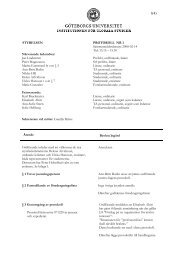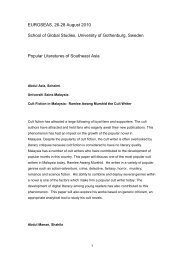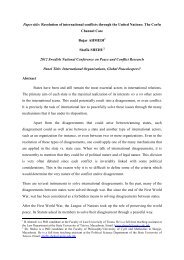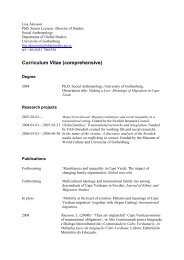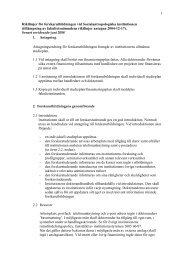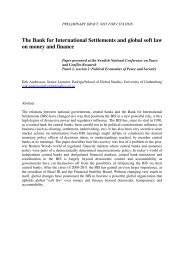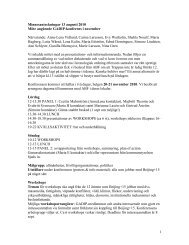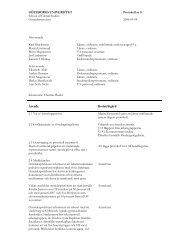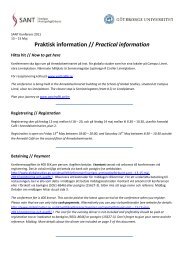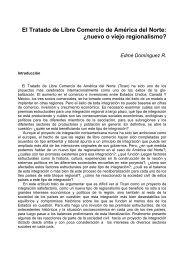1 Understanding food insecurity in rural Rwanda: how women ...
1 Understanding food insecurity in rural Rwanda: how women ...
1 Understanding food insecurity in rural Rwanda: how women ...
You also want an ePaper? Increase the reach of your titles
YUMPU automatically turns print PDFs into web optimized ePapers that Google loves.
availability addresses the “supply side” of <strong>food</strong> security and is determ<strong>in</strong>ed by the level of <strong>food</strong><br />
production, stock levels and net trade.<br />
The paradox regard<strong>in</strong>g <strong>food</strong> availability and <strong>food</strong> <strong><strong>in</strong>security</strong> is that national self-sufficiency is<br />
neither necessary nor sufficient to guarantee <strong>food</strong> security at the <strong>in</strong>dividual level<br />
(Schmidhuber and Tubiello 2007). As examples, Hong Kong and S<strong>in</strong>gapore are not selfsufficient<br />
(agriculture is nonexistent) but their populations are <strong>food</strong>-secure, whereas India is<br />
self-sufficient but a large part of its population is not <strong>food</strong>-secure.<br />
2. Access to <strong>food</strong>: As discussed above, an adequate supply of <strong>food</strong> at the national or<br />
<strong>in</strong>ternational level does not <strong>in</strong> itself guarantee household level <strong>food</strong> security. Food availability<br />
for the nation as a whole or even for the world as a whole does not necessarily translate <strong>food</strong><br />
availability to all sections of a given community or of each <strong>in</strong>dividual household (Sen 1981,<br />
43). Access refers to the household’s or <strong>in</strong>dividual’s command over <strong>food</strong> (Sen 1981), and it is<br />
ensured when all households have sufficient resources to obta<strong>in</strong> appropriate <strong>food</strong>s (through<br />
production, purchase or donation) for a nutritious diet (Gross 2000).<br />
(Maxwell and Smith 1992, 11) discuss access to <strong>food</strong> us<strong>in</strong>g the term ‘entitlement’ and they<br />
say that the entitlement of a person stands for the different alternative commodity bundles that<br />
a person can acquire through the uses of various legal channels of acquirement open to<br />
someone <strong>in</strong> his position. The entitlement relations of <strong>in</strong>dividuals are determ<strong>in</strong>ed by what they<br />
own, what they produce, what they can trade, and what they <strong>in</strong>herit or are given<br />
3. Food utilization: utilization is only discussed from a biological perspective and it<br />
encompasses all <strong>food</strong> safety and quality aspects of nutrition; its subdimensions are therefore<br />
related to health, <strong>in</strong>clud<strong>in</strong>g the sanitary conditions across the entire <strong>food</strong> cha<strong>in</strong> (Gross 2000;<br />
Schmidhuber and Tubiello 2007). It is not enough that someone is gett<strong>in</strong>g what appears to be<br />
an adequate quantity of <strong>food</strong> if that person is unable to make use of the <strong>food</strong>. This is where<br />
<strong>food</strong> security and nutrition get connected. People are <strong>food</strong> secure if the <strong>food</strong> <strong>in</strong>take at their<br />
disposal is beneficial to their bodies and if their bodies use the <strong>food</strong> <strong>in</strong>take <strong>in</strong> a healthy and<br />
nutritious way. Utilization also refers to the proper use of <strong>food</strong> and <strong>in</strong>cludes the existence of<br />
appropriate <strong>food</strong> process<strong>in</strong>g and storage practices, adequate knowledge and application of<br />
nutrition and childcare and adequate health and sanitation services (FAO 2000; FANTA<br />
2006). This dimension is not relevant for the present study due to its biological character and<br />
it won’t be developed further.<br />
11



